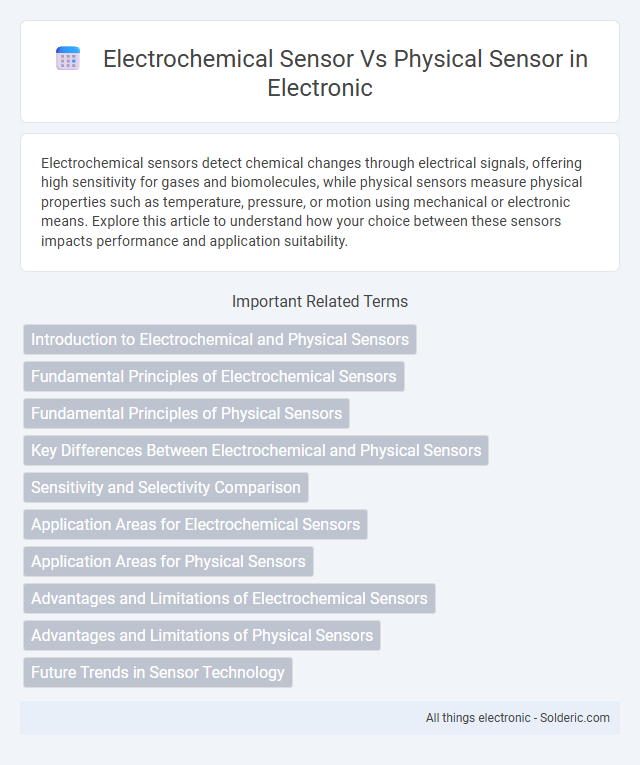Electrochemical sensors detect chemical changes through electrical signals, offering high sensitivity for gases and biomolecules, while physical sensors measure physical properties such as temperature, pressure, or motion using mechanical or electronic means. Explore this article to understand how your choice between these sensors impacts performance and application suitability.
Comparison Table
| Feature | Electrochemical Sensor | Physical Sensor |
|---|---|---|
| Principle | Detects chemical reactions generating electrical signals | Measures physical changes like pressure, temperature, or displacement |
| Applications | Gas detection, biosensing, environmental monitoring | Pressure sensing, motion detection, temperature measurement |
| Sensitivity | High sensitivity to specific chemical compounds | Varies based on type, generally broad physical parameter detection |
| Response Time | Typically milliseconds to seconds | Microseconds to milliseconds |
| Durability | May degrade due to chemical exposure | Generally robust and long-lasting |
| Calibration | Requires frequent calibration for accuracy | Usually stable, less frequent calibration needed |
| Cost | Moderate to high depending on specificity | Low to moderate depending on complexity |
Introduction to Electrochemical and Physical Sensors
Electrochemical sensors detect chemical species by converting chemical information into electrical signals through redox reactions, enabling precise measurement of gases, ions, and biomolecules. Physical sensors measure physical properties such as temperature, pressure, or acceleration by converting mechanical or thermal changes into readable electrical outputs. Electrochemical sensors excel in chemical specificity and sensitivity, while physical sensors provide robust monitoring of environmental and mechanical variables.
Fundamental Principles of Electrochemical Sensors
Electrochemical sensors detect chemical substances by measuring electrical signals generated from redox reactions at the sensor's electrode interface, converting chemical information into quantifiable electrical outputs such as current, potential, or conductivity. Unlike physical sensors that monitor mechanical or physical changes like temperature, pressure, or displacement, electrochemical sensors rely on fundamental principles like oxidation-reduction processes, ion selective electrodes, and amperometric or potentiometric detection techniques. Your choice of sensor depends on the application, with electrochemical sensors offering precise chemical analysis in environments where detecting specific ions or molecules is crucial.
Fundamental Principles of Physical Sensors
Physical sensors operate by detecting changes in physical properties such as temperature, pressure, or displacement through mechanisms like piezoelectricity, capacitance, or resistance variation. These sensors translate mechanical or thermal inputs into electrical signals without involving chemical reactions. Their functionality relies on the direct correlation between the physical stimulus and the measurable electrical parameter, enabling real-time and precise monitoring of environmental or mechanical conditions.
Key Differences Between Electrochemical and Physical Sensors
Electrochemical sensors detect chemical substances by measuring electrical signals generated from chemical reactions, offering high sensitivity and specificity to target analytes like gases or ions, whereas physical sensors measure physical properties such as temperature, pressure, or motion using mechanical or electronic components. Electrochemical sensors typically rely on electrodes and electrolytes to transduce chemical interactions, while physical sensors use transducers such as piezoelectric, capacitive, or resistive elements to detect changes in physical parameters. The selectivity and response mechanisms distinguish electrochemical sensors in applications like environmental monitoring and biomedical diagnostics from physical sensors widely used in industrial automation and structural health monitoring.
Sensitivity and Selectivity Comparison
Electrochemical sensors exhibit higher sensitivity compared to physical sensors due to their ability to detect specific chemical species through redox reactions, enabling precise measurement even at low concentrations. Their selectivity is enhanced by using tailored electrodes and recognition elements that target particular analytes, whereas physical sensors rely on changes in physical properties, which may respond to multiple stimuli, reducing specificity. Your choice of sensor depends on whether selective chemical detection or broader physical parameter monitoring is needed for the application.
Application Areas for Electrochemical Sensors
Electrochemical sensors are widely used in medical diagnostics for monitoring blood glucose and detecting biomarkers due to their high sensitivity and specificity. They play a crucial role in environmental monitoring by measuring pollutants such as heavy metals and toxic gases with rapid response times. Industrial process control benefits from these sensors through real-time detection of chemical concentrations, enhancing safety and efficiency.
Application Areas for Physical Sensors
Physical sensors are widely used in applications requiring measurement of mechanical properties such as pressure, temperature, force, and motion in industries like automotive, aerospace, and manufacturing. Their ability to provide real-time data for structural health monitoring, robotics, and environmental sensing makes them essential for safety and operational efficiency. Your choice of sensor technology depends on the specific physical parameter to be measured and the environmental conditions of the application.
Advantages and Limitations of Electrochemical Sensors
Electrochemical sensors offer high sensitivity and selectivity for detecting specific chemical substances, making them ideal for real-time monitoring of gases, ions, and biomolecules. Their compact size and low power consumption allow for portable and wearable applications, but they can be limited by sensitivity to environmental conditions like temperature and humidity. You should consider potential electrode degradation and the need for frequent calibration to maintain accuracy over time.
Advantages and Limitations of Physical Sensors
Physical sensors offer advantages such as durability, long lifespan, and the ability to measure multiple parameters like temperature, pressure, and displacement with high precision and rapid response times. However, they face limitations including susceptibility to environmental interference, increased size compared to electrochemical sensors, and often higher power consumption. These constraints can impact their integration in compact, energy-efficient applications where sensitivity to specific chemical analytes is required.
Future Trends in Sensor Technology
Future trends in sensor technology highlight the growing integration of electrochemical sensors for their high sensitivity in detecting chemical substances at low concentrations, essential for healthcare, environmental monitoring, and industrial applications. Physical sensors are evolving with advancements in nanomaterials and MEMS (Micro-Electro-Mechanical Systems), enhancing precision in measuring parameters like temperature, pressure, and motion with increased miniaturization and energy efficiency. The convergence of IoT connectivity and AI-driven data analysis accelerates the development of hybrid sensor systems, combining electrochemical and physical sensing capabilities for comprehensive real-time monitoring and predictive maintenance.
electrochemical sensor vs physical sensor Infographic

 solderic.com
solderic.com